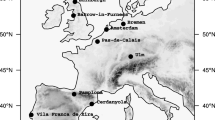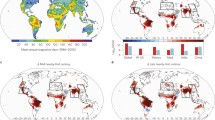Abstract
A large outbreak of Legionnaires’ disease occurred in November 2014 nearby Lisbon, Portugal. This epidemic infected 377 individuals by the Legionella pneumophila bacteria, resulting in 14 deaths. The primary source of transmission was contaminated aerosolized water which, when inhaled, lead to atypical pneumonia. The unseasonably warm temperatures during October 2014 may have played a role in the proliferation of Legionella species in cooling tower systems. The episode was further exacerbated by high relative humidity and a thermal inversion which limited the bacterial dispersion. Here, we analyze if the Legionella outbreak event occurred during a situation of extreme potential recirculation and/or stagnation characteristics. In order to achieve this goal, the Allwine and Whiteman approach was applied for a hindcast simulation covering the affected area during a near 20-year long period (1989–2007) and then for an independent period covering the 2014 event (15 October to 13 November 2014). The results regarding the average daily critical transport indices for the 1989–2007 period clearly indicate that the airshed is prone to stagnation as these events have a dominant presence through most of the study period (42%), relatively to the occurrence of recirculation (18%) and ventilation (17%) events. However, the year of 2014 represents an exceptional year when compared to the 1989–2007 period, with 53 and 33% of the days being classified as under stagnation and recirculation conditions, respectively.







Similar content being viewed by others
References
Allwine KJ, Whiteman CD (1994) Single-station integral measures of atmospheric stagnation, recirculation and ventilation. Atmos Environ 28:713–721
Andrade C, Santos JA, Pinto JG, Corte-Real J (2011) Large-scale atmospheric dynamics of the wet winter 2009–2010 and its impact on hydrology in Portugal. Clim Res 46:29–41
Barros N, Borrego C, Toll I, Soriano C, Jimenez P, Baldasano JM (2003) Urban photochemical pollution in the Iberian Peninsula: Lisboa and Barcelona airsheds. Air Waste Manag Assoc 5:347–359
Berendt RF (1980) Survival of Legionella pneumophila in aerosols: effect of relative humidity. J Infect Dis 141:689 (https://www.ncbi.nlm.nih.gov/pubmed/7373091)
Bližňák V, Valente MA, Bethke J (2015) Homogenization of time series from Portugal and its former colonies for the period from the late 19th to the early 21st century. Int J Climatol 35:2400–2418. https://doi.org/10.1002/joc.4151
Blystad H, Brantsaeter A, Lovoll O (2005) Outbreak of community-acquired legionnaires disease in Southeast Norway, May 2005. Eurosurveillance Wkly 2005:10
Brönnimann S (2015) Climatic changes since 1700. Springer International Publishing, Cham. https://doi.org/10.1007/978-3-319-19042-6_4
Cardoso RM, Soares PMM, Miranda PMA, Belo-Pereira M (2013) WRF high resolution simulation of Iberian mean and extreme precipitation climate. Int J Climatol 33(11):2591–2608. https://doi.org/10.1002/joc.3616
Castilla J, Barricarte A, Aldaz J, García Cenoz M, Ferrer T, Pelaz C, Pineda S, Baladrón B, Martín I, Goñi B, Aratajo P, Chamorro J, Lameiro F, Torroba L, Dorronsoro I, Martínez-Artola V, Esparza MJ, Gastaminza MA, Fraile P, Aldaz P (2008) A large legionnaires’ disease outbreak in Pamplona, Spain: early detection, rapid control and no case fatality. Epidemiol Infect 136(6):823–832. https://doi.org/10.1017/S0950268807009077
Conza L, Pagani SC, Gaia V (2013) Influence of climate and geography on the occurrence of Legionella and amoebae in composting facilities. BMC Res Notes 7:831. https://doi.org/10.1186/1756-0500-7-831
Cortesi N, Gonzalez-Hidalgo JC, Trigo RM, Ramos AM (2014) Weather types and spatial variability of precipitation in the Iberian peninsula. Int J Climatol 34:2661–2677
Dee DP et al (2011) The ERA-interim reanalysis: configuration and performance of the data assimilation system. Q. J. R. Meteorol. Soc. 137(656):553–597 (John Wiley & Sons, Ltd)
Den Boer JW, Yzerman E, Schellekens J, Lettinga KD, Boshuizen HC, Van Steenbergen JE et al (2002) A large outbreak of legionnaires’ disease at a flower show, the Netherlands, 1999. Emerg Infect Dis 8:37–43
Dennis PJD, Lee JV (1988) Differences in aerosol survival between pathogenic and non-pathogenic strains of Legionella pneumophila serogroup 1. J Appl Bacteriol 65:135–141. https://doi.org/10.1111/j.1365-2672.1988.tb01501.x
Dias A, Cysneiros A, Lopes FT, von Amann B, Costa C, Dionísio P, Carvalho J, Durão V, Carvalho G, Paula F, Serrado M, Nunes B, Marques T, Froes F, Bárbara C (2017) The typical presentation of an atypical pathogen during an outbreak of Legionnaires' disease in Vila Franca de Xira, Portugal, 2014. Rev Port Pneumol 23(3):117–123. https://doi.org/10.1016/j.rppnen.2017.01.007
Fisman DN, Lim S, Wellenius GA, Johnson C, Britz P, Gaskins M, Maher J, Mittleman MA, Spain V, Haas C, Newbern C (2005) It’s not the heat, It’s the humidity: wet weather increases Legionellosis risk in the greater Philadelphia metropolitan area. J Infect Dis 192(12):2066–2073. https://doi.org/10.1086/498248
Fraser DW, Tsai TR, Orenstein W, Parkin WE, Beecham HJ, Sharrar RG, Harris J, Mallison GF, Martin SM, McDade JE, Shepard CC, Brachman PS, the Field Investigation Team* (1977) Legionnaires’ disease: description of an epidemic of pneumonia. N Engl J Med 297:1189–1197
Garcia-Fulgueiras A, Navarro C, Fenoll D, Navarro C, Fenoll D, García J, González-Diego P, Jiménez-Buñuales T, Rodriguez M, Lopez R, Pacheco F, Ruiz J, Segovia M, Baladrón B, Pelaz C (2003) Legionnaires’ disease outbreak in Murcia, Spain. Emerg Infect Dis 9(8):915–921. https://doi.org/10.3201/eid0908.030337
Garcia-Vidal C, Labori M, Viasus D, Simonetti A, Garcia-Somoza D, Dorca J, Gudiol F, Carratalà J (2013) Rainfall is a risk factor for sporadic cases of Legionella pneumophila pneumonia. PLoS One 8:e61036
George F, Shivaji T, Sousa Pinto C et al (2016) A large outbreak of legionnaires’ disease in an industrial town in Portugal. Rev Port SaúdePública 34:199–208
Gleason J, Kratz NR, Greeley RD, Fagliano JA (2016) Under the weather: Legionellosis and meteorological factors. EcoHealth 13(2):293–302
Greig JE, Carnie JA, Tallis GF, Ryan NJ, Tan AG, Gordon IR, Zwolak B, Leydon JA, Guest CS, Hart WG (2004) An outbreak of Legionnaires' disease at the Melbourne aquarium, April 2000: investigation and case-control studies. Med J Aust 180(11):566–572
Hicks L, Rose C, Fields B, Drees M, Engel J et al (2007) Increased rainfall is associated with increased risk for legionellosis. Epidemiol Infect 135:811–817
Hunziker S, Gubler S, Calle J, Moreno I, Andrade M, Velarde F, Ticona L, Carrasco G, Castellón Y, Oria C, Croci-Maspoli M, Konzelmann T, Rohrer M, Brönnimann S (2017) Identifying, attributing, and overcoming common data quality issues of manned station observations. Int J Climatol 37:4131–4145. https://doi.org/10.1002/joc.5037
IPMA-Instituto Português do Mar e da Atmosfera (2014). Boletim Climatológico Anual – 2014 Portugal Contiinental. Report, 7pp
Jernigan DB, Hofmann J, Cetron M et al (1996) Outbreak of legionnaires’ disease among cruise ship passengers exposed to a contaminated whirlpool spa. Lancet 347:494–499
Levy I, Dayan U, Mahrer Y (2008a) A five-year study of coastal recirculation and its effect on air pollutants over the East Mediterranean region. J Geophys Res-Atmos 113:D16121
Levy I, Dayan U, Mahrer Y (2008b) Studying coastal recirculation with a simplified analytical land-sea breeze model. J Geophys Res-Atmos 113:D03104. https://doi.org/10.1029/2007JD008628
Levy I, Dayan U, Mahrer Y (2010) Differing atmospheric scales of motion and their impact on air pollutants. Int J Climatol 30:612–619
Marston BJ, Lipman HB, Breiman RF (1994) Surveillance for Legionnaires' disease. Risk factors for morbidity and mortality. Arch Intern Med 154(21):2417–2422
Martins JPA, Cardoso RM, Soares PMM, Trigo I, Belo-Pereira M, Moreira N, Tomé R (2016) The summer diurnal cycle of coastal cloudiness over West Iberia using Meteosat/SEVIRI and a WRF regional climate model simulation. Int J Clim 36(4):1755–1772. https://doi.org/10.1002/joc.4457
Mohan M, Bhati S (2012) Wind flow conditions as an indicator to assimilative capacities of urban airsheds towards atmospheric pollution potential. J Civ Environ Eng, S1:003
Nankar DP, Patra AK, Dole MU, Venkataraman S, Hegde AG (2009) Atmospheric stagnation, recirculation and ventilation characteristics at Kakrapar atomic power station site. Ann Nucl Energy 36:475–480
Nguyen TM, Ilef D, Jarraud S, Rouil L, Campese C, Che D, Haeghebaert S, Ganiayre F, Marcel F, Etienne J, Desenclos JC (2006) A community-wide outbreak of legionnaires disease linked to industrial cooling towers-how far can contaminated aerosols spread? J Infect Dis 193(1):102–111
Nygård K, Werner-Johansen Ø, Rønsen S, Caugant DA, Simonsen Ø, Kanestrøm A, Ask E, Ringstad J, Ødegård R, Jensen T, Krogh T, Høiby EA, Ragnhildstveit E, Aaberge IS, Aavitsland P (2008) An outbreak of legionnaires disease caused by long-distance spread from an industrial air scrubber in Sarpsborg, Norway. Clin Infect Dis 46(1):61–69. https://doi.org/10.1086/524016
Oh I-B, Kim Y-K, Lee HW, Kim C-H (2006) An observational and numerical study of the effects of the late sea breeze on ozone distributions in the Busan metropolitan area, Korea. Atmos Environ 40:1284–1298
Pérez IA, Sánchez ML, García MÁ, Paredes V (2011) Relationship between CO2 at a rural site and integral measures of atmospheric stagnation, recirculation, and ventilation. Naturwissenschaften 98:565–574. https://doi.org/10.1007/s00114-011-0800-5
Pinto RMS, Benali A, Sá ACL, Fernandes PM, Soares PMM, Cardoso RM, Trigo RM, da-Camara CC, Pereira JMC (2016) Probabilistic fire spread forecast as a tool for fire management in an operational setting. SpringerPlus 5:1205. https://doi.org/10.1186/s40064-016-2842-9
Ramos AM, Cortesi N, Trigo RM (2014) Circulation weather types and spatial variability of daily precipitation in the Iberian peninsula. Front Earth Sci 2. https://doi.org/10.3389/feart.2014.00025
Ricketts K, Charlett A, Gelb D, Lane C, Lee J, Joseph C (2009) Weather patterns and Legionnaires' disease: a meteorological study. Epidemiol Infect 137(7):1003–1012. https://doi.org/10.1017/S095026880800157X
Ricketts KD, Joseph CA, Lee JV, Wilkinson P (2012) Wet cooling systems as a source of sporadic legionnaires’ disease: a geographical analysis of data for England and Wales, 1996-2006. J Epidemiol Community Health 66:618–623
Rios-Entenza A, Soares PMM, Trigo RM, Cardoso RM, Miguez-Macho G (2014) Moisture recycling in the Iberian peninsula from a regional climate simulation: spatiotemporal analysis and impact on the precipitation regime. J Geophys Res Atmos 119:5895–5912. https://doi.org/10.1002/2013JD021274
Russo A, Trigo RM, Martins H, Mendes MT (2014) NO2, PM10 and O3 urban concentrations and its association with circulation weather types in Portugal. Atmos Environ 89:768–785
Russo A, Gouveia CM, Levy I, Dayan U, Jerez S, Mendes MT, Trigo RM (2016) Coastal recirculation potential affecting air pollutants in Portugal: the role of circulation weather types. Atmos Environ 135:9–19. https://doi.org/10.1016/j.atmosenv.2016.03.039
Shivaji T, Sousa Pinto C, San-Bento A, Oliveira Serra LA, Valente J, Machado J, Marques T, Carvalho L, Nogueira PJ, Nunes B, Vasconcelos P (2014) A large community outbreak of legionnaires’ disease in Vila Franca de Xira, Portugal, October to November 2014. Euro Surveill 19(50):20991
Sikora A, Wójtowicz-Bobin M, Kozioł-Montewka M, Magryś A, Gładysz I (2015) Prevalence of Legionella pneumophila in water distribution systems in hospitals and public buildings of the Lublin region of eastern Poland. Ann Agric Environ Med 22(2):195–201. https://doi.org/10.5604/12321966.1152064
Skamarock WC et al (2008) A description of the advanced research WRF version 3. NCAR tech. note TN-475_STR, 113 pp
Soares PMM, Cardoso RM, Miranda PMA, de Medeiros J, Belo-Pereira M, Espírito-Santo F (2012) WRF high resolution dynamical downscaling of ERA-interim for Portugal. Clim Dyn 39:2497–2522. https://doi.org/10.1007/s00382-012-1315-2
Soares PMM, Cardoso RM, Semedo A, Chinita MJ, Ranjha R (2014) Climatology of Iberia coastal low-level wind jet: WRF high resolution results. Tellus A 66:22377. https://doi.org/10.3402/tellusa.v66.22377
Soares PMM, Cardoso RM, Lima DCA, Miranda PMA (2017) Future precipitation in Portugal: high-resolution projections using WRF model and EURO-CORDEX multi-model ensembles. Clim Dyn 49:2503–2530. https://doi.org/10.1007/s00382-016-3455-2
Surkova G (2013) Air recirculation and ventilation in the coastal regions of the Black Sea. Cen Eur J Geosci 5(2):196–207
Trigo RM, DaCamara CC (2000) Circulation weather types and their impact on the precipitation regime in Portugal. Int J Climatol 20:1559–1581
Venegas LE, Mazzeo NA (1999) Atmospheric stagnation, recirculation and ventilation potential of several sites in Argentina. Atmos Environ 52:43–57
Walser SM, Gerstner DG, Brenner B, Höller C, Liebl B, Herr CE (2014) Assessing the environmental health relevance of cooling towers: a systematic review of legionellosis outbreaks. Int J Hyg Environ Health 217:145–154
Acknowledgements
The authors would like to acknowledge the European Centre for Medium Weather Forecast for providing the meteorological data. The authors gratefully acknowledge the NOAA Air Resources Laboratory (ARL) for the provision of the HYSPLIT transport and dispersion model and/or READY website (http://www.ready.noaa.gov) used in this publication. Pedro M.M. Soares and Rita M. Cardoso thank the Portuguese Science Foundation (FCT) for funding under Project SOLAR-PTDC/GEOMET/7078/2014. Ana Russo also thanks FCT by the research grant SFRH/BPD/99757/2014.
Author information
Authors and Affiliations
Corresponding author
Electronic supplementary material
ESM 1
(DOCX 274 kb)
Rights and permissions
About this article
Cite this article
Russo, A., Gouveia, C.M., Soares, P.M.M. et al. The unprecedented 2014 Legionnaires’ disease outbreak in Portugal: atmospheric driving mechanisms. Int J Biometeorol 62, 1167–1179 (2018). https://doi.org/10.1007/s00484-018-1520-8
Received:
Revised:
Accepted:
Published:
Issue Date:
DOI: https://doi.org/10.1007/s00484-018-1520-8




